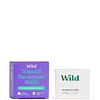What's inside
What's inside
 Key Ingredients
Key Ingredients

 Benefits
Benefits

 Concerns
Concerns

 Ingredients Side-by-side
Ingredients Side-by-side

Propylene Glycol
HumectantWater
Skin ConditioningSodium Stearate
CleansingParfum
MaskingSilica
AbrasiveGlycerin
HumectantSaccharomyces Ferment Filtrate
HumectantDiatomaceous Earth
AbrasivePropanediol
SolventPolyglyceryl-10 Caprylate
EmulsifyingPolyglyceryl-4 Laurate/Succinate
Ethylhexylglycerin
Skin ConditioningTapioca Starch
Sorbitan Oleate Decylglucoside Crosspolymer
CleansingSorbitan Stearate
EmulsifyingBehenyl Alcohol
EmollientSimmondsia Chinensis Seed Oil
EmollientCocos Nucifera Oil
MaskingChamomilla Recutita Flower Extract
MaskingCamellia Sinensis Leaf Extract
AntimicrobialCocos Nucifera Fruit Juice
EmollientPropylene Glycol, Water, Sodium Stearate, Parfum, Silica, Glycerin, Saccharomyces Ferment Filtrate, Diatomaceous Earth, Propanediol, Polyglyceryl-10 Caprylate, Polyglyceryl-4 Laurate/Succinate, Ethylhexylglycerin, Tapioca Starch, Sorbitan Oleate Decylglucoside Crosspolymer, Sorbitan Stearate, Behenyl Alcohol, Simmondsia Chinensis Seed Oil, Cocos Nucifera Oil, Chamomilla Recutita Flower Extract, Camellia Sinensis Leaf Extract, Cocos Nucifera Fruit Juice
Caprylic/Capric Triglyceride
MaskingTapioca Starch
Stearyl Alcohol
EmollientSodium Bicarbonate
AbrasiveTriethyl Citrate
MaskingHelianthus Annuus Seed Cera
EmollientCocos Nucifera Oil
MaskingParfum
MaskingButyrospermum Parkii Butter
Skin ConditioningTheobroma Cacao Seed Butter
EmollientMagnesium Hydroxide
AbsorbentZinc Ricinoleate
Tocopheryl Acetate
AntioxidantHexyl Cinnamal
PerfumingHelianthus Annuus Seed Oil
EmollientBenzyl Salicylate
PerfumingCoumarin
PerfumingTocopherol
AntioxidantCaprylic/Capric Triglyceride, Tapioca Starch, Stearyl Alcohol, Sodium Bicarbonate, Triethyl Citrate, Helianthus Annuus Seed Cera, Cocos Nucifera Oil, Parfum, Butyrospermum Parkii Butter, Theobroma Cacao Seed Butter, Magnesium Hydroxide, Zinc Ricinoleate, Tocopheryl Acetate, Hexyl Cinnamal, Helianthus Annuus Seed Oil, Benzyl Salicylate, Coumarin, Tocopherol
 Reviews
Reviews

Ingredients Explained
These ingredients are found in both products.
Ingredients higher up in an ingredient list are typically present in a larger amount.
Cocos Nucifera Oil is obtained from the kernels of the coconut fruit. In other words, this is coconut oil.
Coconut Oil is rich in fatty acids with lauric acid making up the majority of these. It also contains linoleic acid. Due to this high fatty acid content, coconut oil helps trap moisture and soften skin.
Despite being antibacterial, coconut oil may not be great for acne-prone skin. It is comedogenic and may clog pores. This ingredient may not be safe for malassezia or fungal acne.
Note: Coconut Oil should not replace your sunscreen for UV protection. Studies show it only blocks about 20% of UV.
This oil is non-volatile and has a light scent.
The term 'fragrance' is not regulated in many countries. In many cases, it is up to the brand to define this term. For instance, many brands choose to label themselves as "fragrance-free" because they are not using synthetic fragrances. However, their products may still contain ingredients such as essential oils that are considered a fragrance.
Learn more about Cocos Nucifera OilParfum is a catch-all term for an ingredient or more that is used to give a scent to products.
Also called "fragrance", this ingredient can be a blend of hundreds of chemicals or plant oils. This means every product with "fragrance" or "parfum" in the ingredients list is a different mixture.
For instance, Habanolide is a proprietary trade name for a specific aroma chemical. When used as a fragrance ingredient in cosmetics, most aroma chemicals fall under the broad labeling category of “FRAGRANCE” or “PARFUM” according to EU and US regulations.
The term 'parfum' or 'fragrance' is not regulated in many countries. In many cases, it is up to the brand to define this term.
For instance, many brands choose to label themselves as "fragrance-free" because they are not using synthetic fragrances. However, their products may still contain ingredients such as essential oils that are considered a fragrance by INCI standards.
One example is Calendula flower extract. Calendula is an essential oil that still imparts a scent or 'fragrance'.
Depending on the blend, the ingredients in the mixture can cause allergies and sensitivities on the skin. Some ingredients that are known EU allergens include linalool and citronellol.
Parfum can also be used to mask or cover an unpleasant scent.
The bottom line is: not all fragrances/parfum/ingredients are created equally. If you are worried about fragrances, we recommend taking a closer look at an ingredient. And of course, we always recommend speaking with a professional.
Learn more about ParfumTapioca starch is a thickening agent and is made from the cassava root, also known as yucca.
According to a manufacturer, it is an excellent talc replacement.
It is gluten-free.
Learn more about Tapioca Starch